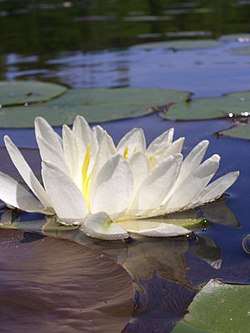Nymphaea odorata
| Habit | aquatic
| |
|---|---|---|
| Lifespan: | ⌛ | perennial |
|
Nymphaea > |
odorata > |
Aiton > |
If this plant info box on watering; zones; height; etc. is mostly empty you can click on the edit tab and fill in the blanks!
Nymphaea odorata, also known as the Fragrant Water Lily and Beaver Root, is a flower belonging to the genus Nymphaea. It can commonly be found in lake shallows, ponds, and permanent slow moving waters throughout North America where it ranges from Central America to northern Canada. It is cultivated in aquatic gardens as an ornamental plant and it easily becomes a noxious weed. It is invasive and weedy on the west coast of North America.
This plant is rooted from a branched rhizomes which give rise to long petioles which terminate in smooth floating leaves. The leaves are very round.[1] The flowers also float and are generally typical of waterlilies. They are radially symmetric with prominent yellow stamens and many white petals. The flowers open each day and close again each night and are very fragrant.
Read about Nymphaea odorata in the Standard Cyclopedia of Horticulture
|
|---|
|
Nymphaea odorata, Ait. (C. odorata, Woodv. & Wood). Sweet-scented Water-lily. Lvs. nearly orbicular, entire, somewhat coriaceous, dark green above, purplish red when young; under surface deep red to reddish green or almost pure green; diam. 5-10 in.; lobes usually diverging, but often touching or slightly overlapping; petioles greenish or brownish: fls. (in the type) white, 3-5 in. across, open 3 days from 6 A.M. till 12 M.; sepals green, tinged with reddish brown; petals 23-32, ovate to lance-ovate; stamens 55-113, yellow; outer filaments broad, white, petaloid; seed medium-sized. E. U. S., common.—Varies greatly in size and color, approaching N. tuberosa. Garden forms selected for size of fl. are called var. superba (.V. superba, Hort.) and N. lactea.
|
Cultivation
Propagation
Pests and diseases
Varieties
Subspecies:
Gallery
References
- ↑ US Department of Agriculture. "Plant Profile". Retrieved on 2008-01-02.
- Standard Cyclopedia of Horticulture, by L. H. Bailey, MacMillan Co., 1963
External links
- w:Nymphaea odorata. Some of the material on this page may be from Wikipedia, under the Creative Commons license.
- Nymphaea odorata QR Code (Size 50, 100, 200, 500)

